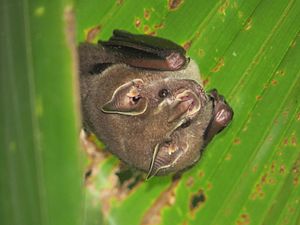Thomas's fruit-eating bat facts for kids
Quick facts for kids Thomas's fruit-eating bat |
|
|---|---|
 |
|
| Conservation status | |
| Scientific classification | |
| Genus: |
Dermanura
|
| Species: |
watsoni
|
| Synonyms | |
|
|
The Thomas's fruit-eating bat (Dermanura watsoni) is a type of bat that eats fruit. It's also sometimes called the Watson's fruit-eating bat. This bat belongs to a group of bats called the Phyllostomidae family.
You can find this bat in southern Mexico, all through Central America, and down to Colombia. In South America, it lives on the western side of the Andes mountains. The bat was named after H. J. Watson. He owned a plantation in Panama and sent animal samples to the British Natural History Museum, London. That's where a scientist named Oldfield Thomas often studied and named new species.
About This Bat's Name
Scientists group living things into different categories, like families and genera. This helps them understand how different species are related. This bat used to be in a group called Artibeus. But in 2004, scientists looked closely at its DNA. They used a special part of its DNA called the cytochrome b gene.
Based on this DNA information, they decided to move the Thomas's fruit-eating bat to a new group called Dermanura. Before, Dermanura was just a smaller part of Artibeus. Now, it's its own separate group. It's interesting because these two bat groups, Artibeus and Dermanura, look very similar. You can't easily tell them apart just by looking at their bodies.
Bats on Isla Escudo de Veraguas
There's a small island off the coast of Panama called Isla Escudo de Veraguas. It's only about 3.4 square kilometers (which is pretty small!). A group of these bats lives there. For a while, scientists thought these island bats were a completely different species. They called them D. incomitata, or the solitary fruit-eating bat.
Because the island is so small and their home was shrinking, these bats were considered to be in great danger of disappearing forever. They were even listed as "critically endangered." But in 2009, scientists looked at their DNA again. They found that the island bats' DNA was very similar to the Thomas's fruit-eating bat. This meant they were actually the same species.
So, the bats on the island are now considered a subspecies of the Thomas's fruit-eating bat. This means they are a special group within the main species. Scientists are still studying them to learn more about how they are related.
See also
 In Spanish: Artibeus watsoni para niños
In Spanish: Artibeus watsoni para niños


